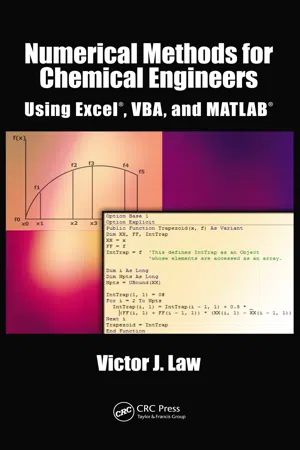Computer Science
Linear Equations in C
Linear equations in C are mathematical expressions that describe a straight line relationship between two variables. In computer science, linear equations are commonly used to model and solve problems related to data analysis, machine learning, and optimization. C is a programming language that provides built-in functions and libraries for working with linear equations.
Written by Perlego with AI-assistance
Related key terms
3 Key excerpts on "Linear Equations in C"
- eBook - ePub
- Oleksandr Kaleniuk(Author)
- 2023(Publication Date)
- Manning(Publisher)
Geometry stands privileged among other mathematical disciplines: it not only relies on linear equations to solve its own problems, but also gives these equations a geometrical meaning, allowing us to understand them through plots and graphics. The most obscure algorithms become comprehendible when you see them in action. This understanding, obtained by watching them work, also helps us competently choose the best algorithms to solve our problems.3.1 Linear equations as lines and planes
A linear equation is a sum of variables multiplied by some coefficients that equals some number. The variables may occur only in power 1. Having an x2 in an equation, for example, disqualifies it as linear, making it quadratic instead. Grouped together, linear equations form a system of linear equations.A solution to a linear system is a set of variables’ values for which all the equations hold. Depending on the system, there could be a single combination, a whole class of them, or none at all. Sometimes, a solution exists, but we have trouble finding it numerically. Sometimes, there are no solutions mathematically, but the one we compute despite its theoretical impossibility is good enough for our needs. Everything depends on the system.This dependency, however, isn’t immediately apparent when all we see are equations made of numbers and letters. But if we rewrite them as geometrical entities, we literally see which systems are easy to solve and which are not.3.1.1 Introducing a hyperplane
This is a linear equation of two variables, x and y:ax + by = cIf we move the coefficient from the right side to the left side, we getax + by - c = 0Never mind the minus sign; this equation is a line equation in 2D. So a linear system of two equations is essentially a system of two lines. The solution to this system is the point where the lines intersect.Awesome! Now we can take our two-trains problem from before and draw it (figure 3.1):Vp - 2Va = 0Va + Vp - 450 = 0Figure 3.1 The two-trains problem as an intersection of lines The solution is immediately apparent: It’s where the lines intersect. In figure 3.1, the solution is the point (300, 150). We can do the same thing in 3D. A linear equation like this - Victor J. Law(Author)
- 2013(Publication Date)
- CRC Press(Publisher)
3 Linear Algebra and Systems of Linear Equations
3.1 INTRODUCTION
Linear algebra is a topic that many students of numerical methods will have been exposed to in mathematics classes. In this chapter, a brief review of linear algebra is given along with numerical methods for solving problems that are common in engineering and scientific applications. Linear algebra involves the manipulation of linear relationships and usually involves the use of vectors and matrices. The most common problem class of linear algebra is the solution of a set of linear algebraic equations.3.2 NOTATION
• Scalars are indicated by a lowercase letter. • Vectors are also identified by a lowercase letter. The context distinguishes between a scalar and a vector. • Matrices are designated by a capital letter.• By default, vectors are column vectors. To show a row vector, the transpose operator (a superscript T ) is used (as in x T ).• When necessary, the dimensions of matrices and vectors are shown by scalar subscripts. For example, A m × n indicates a matrix with m rows and n columns. Further, y n ×1 designates a column vector of n elements.Definition: The equationwhere a , b , c , d , and h are known numbers, while x , y , z , and w are unknown numbers (variables), is called a linear equation . If h = 0, the linear equation is said to be homogenous . A linear system is a set of linear equations, and a homogenous linear system is a set of homogenous linear equations.For example, is a linear system. Butis a nonlinear system (because of ).The system is a homogenous linear system. Vectors and matrices offer a convenient, compact way of representing, manipulating, and solving linear systems. These are introduced in the next few sections.3.3 VECTORS
A vector is an ordered set of numbers arranged as a column (the default). An m- eBook - ePub
- Boris Pritsker(Author)
- 2019(Publication Date)
- Dover Publications(Publisher)
Chapter 1 Linear EquationsAn equation is a statement that claims that two quantities are equal. In mathematics the term “equation” means equality with one or more variables or unknowns. “Variable” comes from the Latin translation “capable of changing.” Our ancestors in ancient Babylonia and Egypt stated and solved problems using equations, but not in the same way it is done today. They did not identify any formulas or algorithms for solving equations, but everything was “solved” in verbal descriptions and instructions. Representing known and unknown quantities by letters (variables) was first done by the French attorney François Viète (1540–1603). It was his brilliant idea to work with letters as if they are numbers and obtain the result in which the numbers are substituted at the very end to get the answer. Though not a professional mathematician by education, Viète made quite remarkable contributions to the field of mathematics. He was the first to introduce notations for problem solutions and to formalize mathematics, which allowed for a simplification of algebraic manipulations. Without his accomplishments, it would not be possible to work easily with equations. His approach to use the “variable” as a supplemental tool for solving different problems was a huge step forward in the development of contemporary algebra. He created a new language that allows us to express ideas, logic, and problems in an organized and systematic way.Viète suggested three stages in solving a problem: First, summarize the problem in the form of an equation. Denote the known quantities by constants-consonants (Viète was the first to use the term coefficients to define the numbers in an equation) and unknown by variables-vowels. In 1637 the great French mathematician and philosopher René Descartes (1596–1650) suggested using x , y , z (the last letters in the alphabet) as variables and a , b , c
Index pages curate the most relevant extracts from our library of academic textbooks. They’ve been created using an in-house natural language model (NLM), each adding context and meaning to key research topics.


